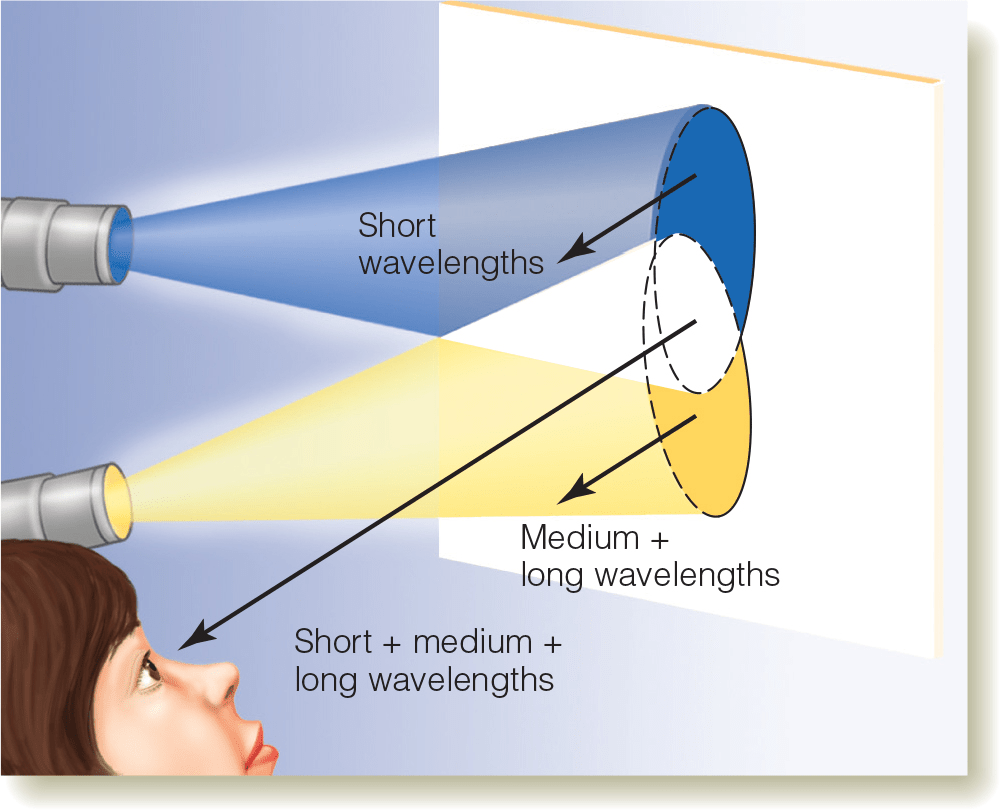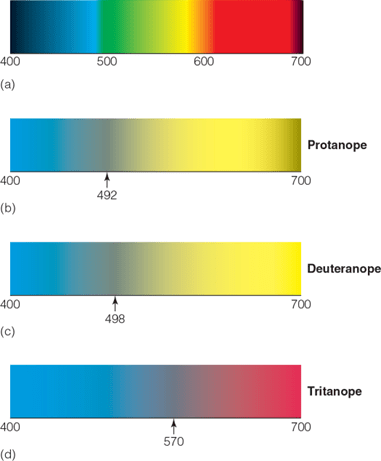You can add more lights to cancel out the original light's color through this process, such as using cyan to cancel red or blue to cancel yellow.
What is additive color mixing?

This term describes the slight difference between the images seen by each eye, which the brain uses to perceive depth.
What is binocular disparity?
These regions in the visual cortex can change in size and location based on attentional demands, focus, and the presence of distracting stimuli.
What are receptive fields?
These rapid, jerky eye movements shift the focus of vision from one point to another, occurring when scanning a scene or reading.
What are saccades?
This phenomenon keeps us from perceiving a blur or smear across the visual field during rapid eye movements by briefly reducing visual sensitivity.
What is saccadic suppression?
When you place a blue square next to a yellow background, this effect makes the blue appear more vivid and distinct.
What is color contrast?

These depth cues, such as occlusion, relative size, and linear perspective, can be perceived using just one eye.
What are monocular depth cues?
This phenomenon occurs when a visual change in a scene goes unnoticed, especially when attention is diverted or focused elsewhere.
What is change blindness?
This type of motion, defined by texture change instead of luminance change, is only seen in the lab.
What is second-order motion?
This brain region is involved with perceiving the motion of people and animals.
What is the posterior superior temporal sulcus?
or What is the STSp?
These two vision deficiencies would make it difficult for someone to distinguish between red and green colors.
What is deuteranopia or protanopia?

These have no disparity and therefore can't contribute to binocular vision.
What are objects on the horopter?
or
What are corresponding points?
This theory proposes that while basic visual features like color and shape can be processed without focused attention, binding these features together to perceive a coherent object requires selective attention.
What is Feature Integration Theory?
This phenomenon occurs when stationary objects in your visual field disappear from awareness as a result of surrounding motion.
What is motion-induced blindness?
We use this to calculate Time To Collision.
What is Tau?
This phenomenon ensures that the perceived color of objects remains relatively stable under varying lighting conditions.
What is color constancy?
This approach to perception uses prior knowledge and probabilities to interpret ambiguous sensory information and make predictions about the most likely outcome.
What is the Bayesian approach?
In scene perception, this attention pathway processes object identity, loosely similar to the 'what' pathway in visual processing.
What is the selective pathway?
This brain area becomes active when processing complex motion, such as when navigating through your environment while walking.
What is the MST?
or
What is the medial superior temporal area?
This phenomenon occurs when a second target is missed if it appears within 200–500 milliseconds after a first target in a rapid stream of stimuli, due to a temporary gap in attention.
What is the attentional blink?
This term describes the percentage of light that a surface reflects at each wavelength, helping determine the color we perceive.
What is spectral reflectance? or What is the density of reflected light?
These do not prioritize any one cue over others across contexts.
What are Perceptual Committees?
This early selection model of attention suggests that information is filtered based on physical attributes before reaching higher levels of processing
What is Broadbent's Filter Model?
This mechanism explains how the brain uses a copy of motor commands to prevent confusion between actual motion in the environment and motion caused by eye movements.
What is Corollary Discharge Signal?
This is the inability to perceive depth using binocular disparity
What is stereo blindness?